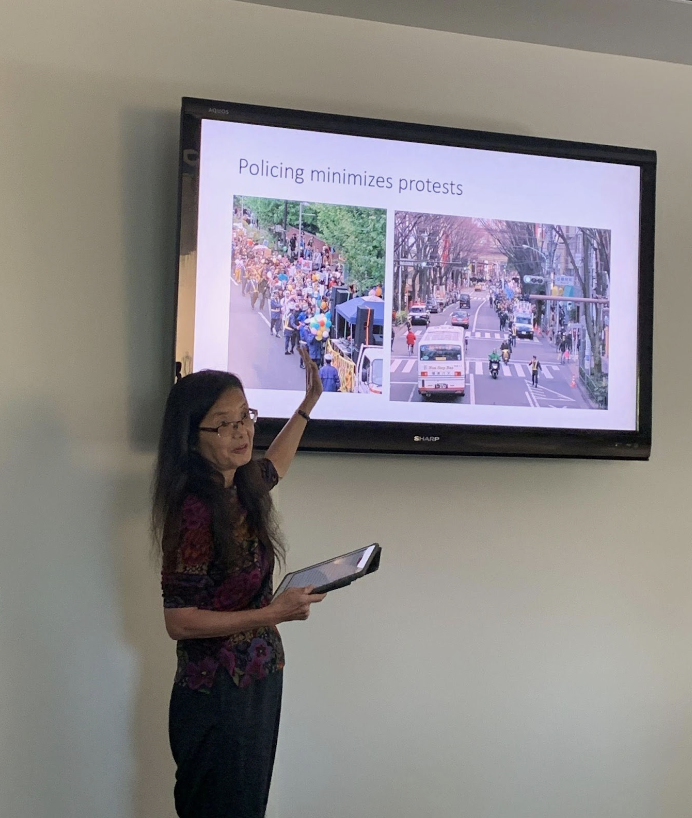By Makenna Gaeta
Japanese protestors use sound very differently than Americans, relying more on protest music, a UC Santa Barbara audience was told.
Noriko Manabe, a leading scholar in ethnomusicology at both Stanford and Temple University, visited UCSB to host Takashima Talks: The Democracy That Society Allows— Protest Sounds in Japan and the US.
“Music and sound can move us to charge, raise our voices, and feel nationalistic pride or ‘rage against the machine.’ My talk considers the factors that shape the sound of protests and participation in the contrasting dynamics between Japan and the US,” Manabe said.
The Department of East Asian Languages and Cultural Studies hosted the event as part of its Takashima Talks program, featuring “cutting-edge scholarship that probes the field’s methodologies and boundaries.” Manabe’s ethnomusicology monograph, The Revolution Will Not Be Televised: Protest Music After Fukushima, won the Jon Whitney Hall Book Award from the Association for Asian Studies.
After participating in New York City’s 2017 Women’s March, Manabe was “struck” by the quietness of the protest in comparison to those she had previously witnessed in Tokyo— a densely populated hub with a similar architectural plan to that of midtown Manhattan. “Given the similar urban setting, I had expected similar behaviors and sounds. And while drum corps and brass bands were present, I didn't see them in my two walkthroughs of the Women’s March, and they didn't seem as ubiquitous as in Japanese protests,” she said.
Manabe attributes this difference in protest music to Japan’s higher level of police presence and scattered, less accessible public spaces in cities. Crammed into narrow sidewalks with no road access, Japanese protestors divide into fragmented subgroups, lacking the unity that come with large numbers.
Ethnomusicologist Noriko Manabe discusses protest music within Japan and the US during a talk for the Department of East Asian Languages and Cultural Studies
Policing poses a further constraint. “Officers do everything in their power to make protests look small,” she said. Manabe estimates that there is likely one police officer for every 10 protestors within a typical Japanese demonstration, making it easy to surround protestors and detract from their visibility.
“They find a way to divide you up into smaller chunks, typically of about 500 to 1000 people. So you could be in a demonstration that has 200,000 people. But if you didn't know what was going on and you were just passing by, you'd probably think that the protest was only about 500 people,” Manabe said.
This is where sound comes in. Stripped of their visibility, Japanese protestors rely on protest sounds—music and chanting— to occupy space and attract attention. In Japan’s 2011 anti-nuclear protests, sound trucks, or vehicles equipped with music accessories and performers, attracted thousands of first-time demonstrators.
“The sound truck was a tool that overcame the constraints that were placed on Japanese protests. The trucks’ height and noise ensure that they will be seen and heard; it is also a forum in which bystanders and protestors can participate,” she said.
Compared to the splintered groups of protestors within Japan’s antinuclear movement, the New York Women’s March was a visual spectacle. An uninterrupted mass of 100,000 protestors flooded the entire width of Fifth Avenue— but they were silent. “As a longtime New York resident, I found this silence pretty eerie. The footsteps of the crowd were giving this kind of low-level hum,” Manabe said.
According to Manabe, the Women’s March was viewed by the public as less threatening than movements like Black Lives Matter and Occupy Wall Street, leading to minimal policing and complete road access. But this lack of constraint— in contrast to Japan’s— meant less unity was created through protest music and chanting. “In the Women's March, you had individual protesters who would spontaneously chant something here and there. And sometimes the chant would inspire a group of people nearby, but most of the time, it would quickly die,” she said.
Manabe says her goal is not to make claims about inherent cultural differences between Japan and America. Rather, her research uncovers factors that shape how people occupy space “both physically and sonically.” When divided and policed, sound prevails. “Sounds impact us emotionally and kinetically,” said the ethnomusicologist. “You can’t close your ears.”
Makenna Gaeta is a second-year Communication Major. She covered this event for her Writing Program course Digital Journalism.



